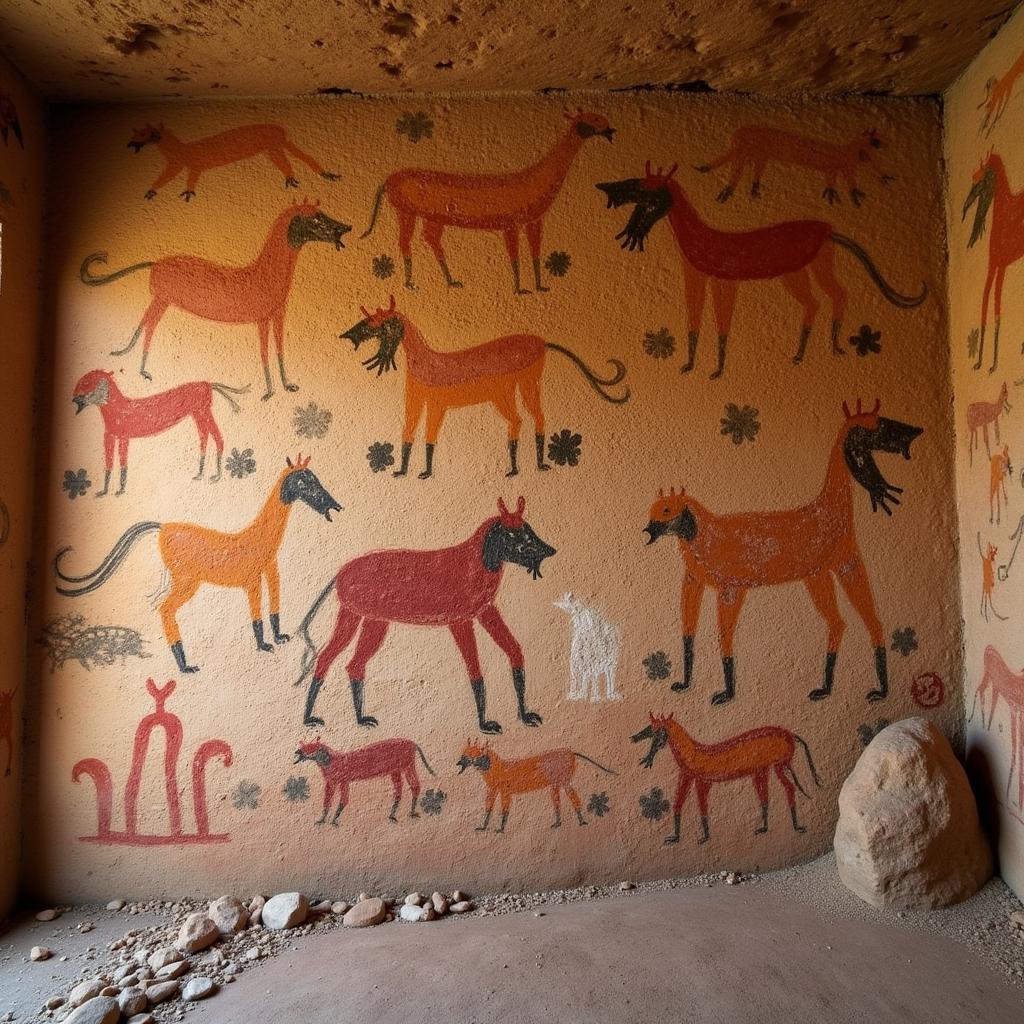A Journey Through the History of Wall Art
Wall art, in its myriad forms, has been an intrinsic part of human expression since our earliest ancestors first adorned cave walls with ochre and charcoal. From those rudimentary beginnings to the diverse and technologically advanced art forms we see today, the History Of Wall Art offers a fascinating glimpse into the evolution of human creativity, culture, and technology. This journey through time reveals how wall art has not only reflected societal shifts but also actively shaped our perceptions of the world.  Ancient Cave Paintings: The Dawn of Wall Art
Ancient Cave Paintings: The Dawn of Wall Art
From Caves to Castles: Early Forms of Wall Art
The earliest forms of wall art, found in caves like Lascaux and Chauvet in France, date back tens of thousands of years. These Paleolithic paintings, primarily depicting animals, offer valuable insights into the lives and beliefs of our hunter-gatherer ancestors. As civilizations emerged, wall art evolved. Ancient Egyptians adorned tomb walls with intricate hieroglyphics and vibrant scenes of daily life, ensuring the deceased’s smooth passage into the afterlife. Similarly, frescoes and mosaics became prominent features of Roman villas and public buildings, showcasing mythological narratives and scenes of Roman grandeur.
The Rise of Religious Iconography in Wall Art
The medieval period saw a significant shift in the focus of wall art, with religious iconography taking center stage. Stained-glass windows illuminated cathedrals, narrating biblical stories to a largely illiterate population. Tapestries, often depicting scenes of chivalry and courtly life, added warmth and decoration to castle walls. This era highlights the power of wall art to communicate complex narratives and reinforce societal values.
The Renaissance and Beyond: Artistic Innovation and New Techniques
The Renaissance marked a period of artistic rebirth, and wall art flourished. Fresco painting experienced a resurgence, with masters like Michelangelo and Raphael creating iconic works such as the Sistine Chapel ceiling and The School of Athens. navajo wall art were appreciated for their unique aesthetics. The development of oil painting further expanded the possibilities for wall art, allowing for greater detail and richer colors. This period underscores the importance of artistic innovation in driving the evolution of wall art.
The Impact of Printing and Photography on Wall Art
The invention of the printing press in the 15th century democratized access to art, making reproductions of famous paintings widely available. The advent of photography in the 19th century further transformed the landscape of wall art. Photographs, initially seen as a purely documentary medium, gradually gained acceptance as a legitimate art form, offering new perspectives and challenging traditional artistic conventions.
Modern and Contemporary Wall Art: Exploring New Frontiers
The 20th and 21st centuries have witnessed an explosion of creativity in wall art. Modern art movements like Cubism, Surrealism, and Abstract Expressionism challenged established notions of representation and explored new forms of visual language. ak47 wall art became a unique and bold statement. The rise of street art brought art into the public sphere, transforming urban landscapes into vibrant canvases. Digital art and installation art further pushed the boundaries of what wall art could be, incorporating technology, light, and interactive elements.  Modern Street Art: A Canvas for Urban Expression
Modern Street Art: A Canvas for Urban Expression
What are the Different Types of Wall Art Throughout History?
From ancient cave paintings to modern digital installations, the variety is astounding. We’ve seen mosaics, frescoes, tapestries, oil paintings, prints, photographs, and so much more. Each medium reflects the technology and artistic sensibilities of its time.
How Has Wall Art Reflected Societal Changes?
Wall art acts as a mirror to society, reflecting its values, beliefs, and concerns. Religious iconography dominated during the medieval period, while the Renaissance saw a renewed focus on humanism and classical ideals. Modern and contemporary art often grapple with social and political issues, providing commentary on the world around us.
What is the Significance of Wall Art in Different Cultures?
Wall art plays a crucial role in shaping cultural identity. It can communicate history, mythology, and traditions, preserving and transmitting cultural knowledge across generations. fleur de lis wall art carries historical and symbolic significance. Different cultures have unique artistic styles and traditions, contributing to the rich tapestry of global art history. vintage art deco wall sconce are also wonderful examples.
Conclusion
The history of wall art is a testament to the enduring human impulse to create, express, and decorate. From the earliest cave paintings to the cutting-edge digital art of today, wall art continues to enrich our lives, challenge our perceptions, and connect us to the past. vintage aviation wall art is a niche but fascinating area to explore. This ongoing evolution promises an exciting future for the history of wall art, inviting us to participate in its ever-unfolding narrative.
When you need assistance, please contact us:
Phone Number: 02462573573
Email: [email protected]
Address: Savico Megamall, 7-9 Đ. Nguyễn Văn Linh, Gia Thụy, Long Biên, Hà Nội 10000, Việt Nam.
Our customer support team is available 24/7.


